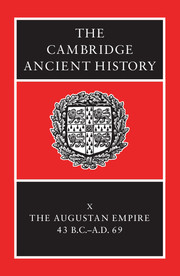6 - From Nero to Vespasian
from PART I - NARRATIVE
Published online by Cambridge University Press: 28 March 2008
Summary
A.D. 68
In January 68, Nero had been persuaded by his freedman Helius to break off his successful and popular tour of Greece and return to Italy immediately. The fact that Helius braved the winter storms to cross the Adriatic confirms that he was deeply concerned about the possibility not just of a conspiracy among members of the Senate at Rome, but of a rising by one or more provincial governors with their armies. The evidence for this was a series of letters calling for Nero's overthrow circulated to other governors by C. Iulius Vindex, probably the legate of Gallia Lugdunensis. Some of the recipients passed the letters they received from Vindex on to Rome via local imperial procurators. But those who were administering the government on Nero's behalf cannot have been certain which governors if any were still to be trusted.
Imperial procurators in Tarraconensis, for instance, will have realized that the legate, Servius Sulpicius Galba, was taking no action to punish those who were circulating verses hostile to Nero. No one could tell whether Galba might not be similarly tolerant of those – perhaps the same people – who were plotting armed disloyalty.
The only direct evidence we have for assessing Vindex's reasons for rebelling, and his objectives, are the anti-Neronian writings he circulated, and the inscriptions on the coins he minted to pay his followers. Suetonius tells us that Vindex referred to Nero as ‘Ahenobarbus’, emphasizing that he had not been born a member of the domus Caesaris, and condemned him for his philhellenism: he was a charioteer and lyre-player with a weak voice.
- Type
- Chapter
- Information
- The Cambridge Ancient History , pp. 256 - 282Publisher: Cambridge University PressPrint publication year: 1996
References
- 19
- Cited by

